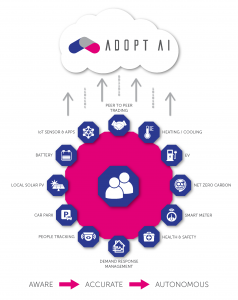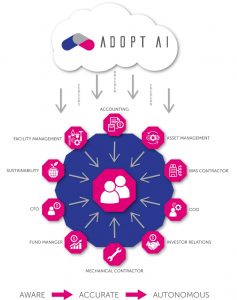The world of technology is moving at a pace we have never seen before. All businesses, countries and individuals alike are focused on what’s often touted as the “biggest risk that mankind has ever faced”, climate change. Larry Fink, the CEO of Blackrock, the world’s largest fund manager, recently said in his annual letter to CEO’s, “There is no company whose business model won’t be profoundly affected by the transition to a net zero economy. The signal is becoming undeniable to the boardroom that mainstream finance truly regards climate risk as financial risk, and it is their business to create and disclose credible transition plans.”
In the built environment, Building and construction are responsible for 39% of all carbon emissions in the world, with operational emissions (from energy used to heat, cool and light buildings) accounting for 28%. the remaining 11% comes from embodied carbon emissions. Heating, cooling and hot water makes up 60% of energy usage.
Is technology the answer to our sift in habits and consumption to mitigate the climate change risks?
To retain a focus on the built environment, we will explore what we think the future holds for this sector and how technology will dramatically change the way buildings are managed and operated.
There are 3 important horizontals to consider when looking at the future ecosystem that will exist in our buildings.
- Hardware IoT devices
These are incredibly important because this provides valuable data. IoT (Internet of Things) is a new term, it basically means using sensors and hardware devices to gather data from physical ‘things’ and put it on the internet, ie digitize it. What’s important is that this ‘data enabler’ is easy to deploy, affordable, secure and provides reliable real time data to a cloud source. Centralising data is paramount so that you can optimise it in the most commercial way.
- Middleware
With the advances in hardware and edge computing, the next key link between the IoT data which is all wireless (easy to deploy, scale, affordable), is the transmission of this data to a cloud source. What’s important here is that it is reliable, real time, affordable, flexible, secure and interoperable. There is huge progression in this space using lots of protocols like Bluetooth, Wifi, cellular, lorawan and Sigfox to name a few.
- Software
This will be the critical management piece for large volumes of data because it will enhance productivity, get teams working better together, improve accuracy and efficiency and provide end users a digital tool to leverage in their everyday roles. What’s important here is that it is flexible, customisable, easy to use, real time, future proofed, incorporates artificial intelligence and machine learning, provides commercial outcomes to end users.
Artificial intelligence will have a profound impact on how we make decisions in every aspect of our lives. Computerized decision making will guide us nearly as much as our brains do now. The concept of AI is not new, it was introduced in 1956, at a conference at Dartmouth college in the US and while a lot has changed since then, the concepts remain the same. Right now whether you like it or not it is easy for anyone to access your digital data to learn a tremendous amount about what you’re like and this data can be fed into computers that do everything from predict what you want to buy to what you value in life. While this may be scary to many, it produces remarkable results.

Figure 1. Data can be enabled more flexibly and commercially now so that an ecosystem of assets can produce real time data enabling AI and machine learning to provide prioritise insights to various layers of management.
The beauty of this revolutionary technology is that it takes in data all day every day, detects anomalies and patterns based on the relevant criteria and then recommends an action. This allows us to make more informed and less emotional decisions much faster than we could on our own. We will use machine assistance as much for decision making as we do for information gathering today. Humans and AI are far better to work together because it produces the best results.
There is a high probability that a computer can never replicate many of the things the brain can do, things like imagination, synthesis and creativity, because the brain comes genetically programmed with millions of years of abilities honed through evolution. The science of decision making that underlies many computer systems remains much less valuable than the art. People still make the most important decisions better than computers do. Look no further than those who are uniquely successful, its not the software engineers or mathematicians game theory modellers but those people with the most common sense, imagination and determination.
Most important of all they are independent and immune to the biases of crowds, they do not care if what they see or do is unpopular and they don’t panic.
As technology costs have fallen and the sophistication of IoT devices have increased, it is easier to generate data on the performance of buildings, assets and the systems of systems within them at a more granular level.
At its core, IoT enables different components to communicate with each other with little to no intelligence. This lack of intelligence means that a building may generate a deluge of data that needs to be manually sifted through to glean operational insights, proficiencies, and advantages. It is these characteristics that underscore how commercial buildings benefit from disruptive technologies like AI – turning data into actionable information to aid facility operations and personnel. Without data, IoT, and AI, the combining of data to generate actionable intelligence is either time-consuming, involves humans and therefore laden with inconsistency, costly, or (often) deemed useless.

Figure 2. Data can be distilled to benefit many across an organisation leading to improved productivity and data backed decision making
This crisis may further change the way tenants utilise their space, with more hot desks, new norm social distancing and variable space. Understanding these patterns will become more important in the future, both for landlords and tenants, and how this translates to operations and energy management, revenue and costs.
A data driven operation will be essential to maintain high performance at competitive prices. The use of AI to assist managers to run such facilities will be vital as the amount of data that comes online in the next few years will become overwhelming. To have a platform that can ingest huge amounts of data and deliver prioritised commercial insights, will be key to the successful delivery of facilities and will benefit many within the organisation.

